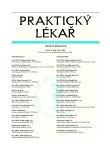Music and human brain
Authors:
F. Koukolík
Authors‘ workplace:
Primář: MUDr. František Koukolík DrSc.
; Národní referenční laboratoř prionových chorob
; Fakultní Thomayerova nemocnice s poliklinikou, Praha
; Oddělení patologie a molekulární medicíny
Published in:
Prakt. Lék. 2009; 89(3): 120-124
Category:
Various Specialization
Overview
This short and selective revue describes the relationship between the brain and music, music as an adaptation, phylogenesis and ontogenesis of music, the music-language relationship, the domain specificity and neuronal representation of music.
Key words:
music, human brain, neuronal representation.
Sources
1. Douglas, K.M., Bilkey, D.K. Amusia is associated with deficits in spatial processsing. Nat. Neurosci. 2007, 10, p. 915-921.
2. Fitch, W.T. The biology and evolution of music: a comparative perspective. Cognition 2006, 100, p. 173-215.
3. Gaser, Ch., Schlaug, G. Brain structures differ between musicians and non-musicians. J. Neuroscience 2003, 23, p. 9240-9245.
4. Gould, S.J., Lewontin, R.C. The spandrels of San Marco and panglossian paradigma of the adaptationist program. Proc. Royal Soc. London. B. 1979, 205, p. 581-598.
5. Koelsch, S., Siebel, W.A. Towards a neural basis of music perception. Trends in cognitive sciences 2005, 9, s.578-84.
6. Koukolík, F. Před úsvitem, po ránu. Eseje o dětech a rodičích. Praha: Karolinum, 2008. ISBN 978-80-246-1496-0.
7. Marques, C., Moreno, S., Castro, S.L. et al. Musicians detect pitch violation in a foreing language better than non-musicians: behavioral and electrophysiological evidence. J. Cogn. Neurosci. 2007,19, p.1453-1463
8. Miller, G. Evolution of human music through sexual selection. In: The origins of music. Wallin N, Merker B, Brown S (eds.) Cambridge, MA: MIT Press 2000, p. 329-360.
9. Nan, Y., Knösche, T.R., Zysset, S. et al. Cross cultural music prase processing: a fMR study. Hum. Brain Mapp. 2008, 29, p. 312-328.
10. Patel, A.D., Peretz, I., Tramo, M., et al. Processing prosodic and musical patterns: A neuropsychological investigation. Brain Lang. 1998, 61, p. 674-681.
11. Patston, L.L., Kirk, I.J., Rolfe, M.H. The unusual symmetry of musicians: musicians have equilateral interhemispheric transfer for visual information. Neuropsychologia 2007, 45, p. 2059-2065.
12. Peretz, I. Can we lose memory for music? The case of music agnosia in a nonmusician. J. Cogn. Neurosci. 1996, 8, p. 481-496.
13. Peretz, I. The nature of music from a biological perspective. Cognition 2006, 100, p. 1–32.
14. Peretz, I, Cummings. S., Dubé, M-P. The genetic of congenital amusia (tone deafness: a family aggregation study. Am. J. Hum. Gen. 2007, 81, p. 582-588.
15. Pinker, S. How the mind works. London: Allen Lane, 1997. ISBN 0-393-31848-6pbk.
16. Schön, D., Lorber, B., Spacal, M. et al. A selective deficit in the production of exact musical intervals following right-hemisphere damage. Cogn. Neuropsychol. 2004; 21: p. 773-784.
Labels
General practitioner for children and adolescents General practitioner for adultsArticle was published in
General Practitioner

2009 Issue 3
- Hope Awakens with Early Diagnosis of Parkinson's Disease Based on Skin Odor
- Metamizole at a Glance and in Practice – Effective Non-Opioid Analgesic for All Ages
- Metamizole vs. Tramadol in Postoperative Analgesia
- Memantine in Dementia Therapy – Current Findings and Possible Future Applications
- Memantine Eases Daily Life for Patients and Caregivers
Most read in this issue
- Corticosteroids as a treatment of rheumatoid arthritis
- A new anti-obesity drug on the horizon?
- Addictive drugs in primary care
- Infections imported from exotic countries
